|

songs | interviews | photos | tours | boots | press releases | timeline
Sound On Sound (UK)
Europe's no.1 Hi-tech music recording magazine
July 1998
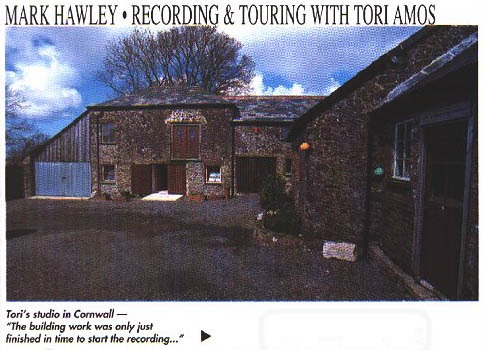
CHECKING IN WITH THE CHOIRGIRL
MARK HAWLEY: RECORDING AND TOURING WITH TORI AMOS
Tori Amos may not yet have attained the same status in the UK that she enjoys in the US, but that hasn't stopped her setting up her own studio in a quiet corner of Cornwall. On the eve of her forthcoming 200-date tour, Hugh Robjohns talked to Mark Hawley and Marcel Van Limbeek about recording Tori's latest album and engineering the live tour.
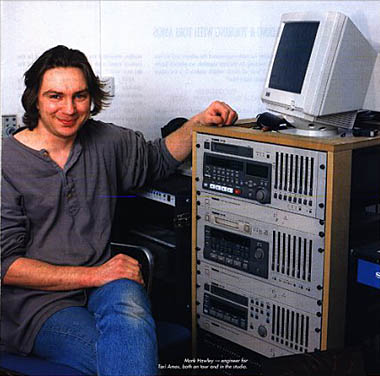
For Tori Amos, success was anything but an overnight affair. In the late '70s, at the age of 13, she was playing popular easy-listening standards in the hotels around her home town of Washington. By 1984 she had moved to Los Angeles and signed her first record deal, with Atlantic Records, for her band Y Kant Tori Read. The fact that you have probably never heard of them says it all. The band was not a huge success and their only eponymously-titled album was largely ignored.
Tori's first piano and voice solo album, however, made quite an impression. Little Earthquakes, released in 1992, paved the way for the huge following she now enjoys. Under the Pink followed in 1994, and it was during the tour to support this second solo album that Mark Hawley and Marcel Van Limbeck first met up with Tori.
Mark was the tour's FOH engineer, with Marcel on monitors. Following the positive reception afforded some of their live recordings, which were released as B-sides, Mark and Marcel were asked to engineer Tori's 1996 follow-up album, Boys for Pele. This marked a significant departure for Tori, in that she no longer recorded as a solo singing piano player, thanks to contributions from guitarist Steve Caton. Anyone familiar with these three albums will be wondering what on earth I'm on about, as many of the tracks feature extensive musical arrangements with a wide variety of other instrumentation -- but this was all added after the original voice and piano recordings.
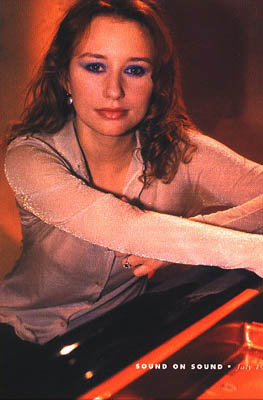 Her latest album, From the Choirgirl Hotel is different again in that for these sessions Tori played live with a band: Matt Chamberlain (drums), Steve Caton (Guitar), and George Porter or Justin Meldal-Johnsen (bass). The Album was recorded and mastered in Tori's brand-new studio, built in a converted barn adjoining a 300 year-old farm cottage near Bude in Cornwall.
Her latest album, From the Choirgirl Hotel is different again in that for these sessions Tori played live with a band: Matt Chamberlain (drums), Steve Caton (Guitar), and George Porter or Justin Meldal-Johnsen (bass). The Album was recorded and mastered in Tori's brand-new studio, built in a converted barn adjoining a 300 year-old farm cottage near Bude in Cornwall.
One way or another it has been a very busy year for Mark and Marcel. After completing the Pele tour, Mark married Tori in February, and in September work started on their new studio. In fact, the building work was barely completed in time to start the new album, and only a few months later they were mixing and mastering its 12 tracks. The ink was hardly dry on the advance CDs when in early April Tori and her new band were in North London rehearsal rooms polishing their act for the start of a 200-date world tour.
After finishing their last rehearsal, Mark and Marcel talked to Sound on Sound about their new studio, recording Tori's latest album, and their approach to the tour, whilst all around us flight cases were being packed up and wheeled out to a waiting truck. Hours later the whole entourage flew out to the USA for a pre-tour live performance on the David Letterman show. I began by asking how Mark and Marcel started working together.
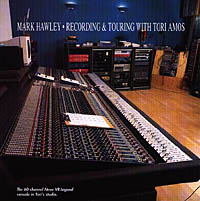 Mark Hawley: "I started in studios years and years ago but became bored being in the studio all the time. I was working at a level where I could not record the kinds of things I liked anyway, so it made sense to move over into the live thing, and it was when I was working for a little PA company in Kings Cross that Marcel walked in -- with a very poor English accent -- looking for work. We immediately got on well and were soon working together a lot on small tours and gigs.
Mark Hawley: "I started in studios years and years ago but became bored being in the studio all the time. I was working at a level where I could not record the kinds of things I liked anyway, so it made sense to move over into the live thing, and it was when I was working for a little PA company in Kings Cross that Marcel walked in -- with a very poor English accent -- looking for work. We immediately got on well and were soon working together a lot on small tours and gigs.
"I had known John Witherspoon (Tori's tour manager) for ages, and had done lots of work with him in the past, so when he offered me the Tori Amos tour in 1994 I asked if Marcel could come along to do the monitors. Initially, Marcel was only going to be on the job for a couple of weeks for the UK dates, but it all went so well that Tori insisted we both stayed on -- and we're still doing it five years later!
"Halfway through Tori's '94 tour we recorded some B-sides from the stage show and everyone loved the sound of those, so were were talked into engineering Boys For Pele, which was very good for us. Live sound and the studio are very different cultures and I think that had a lot to do with the sound we achieved on the last album -- especially on how dynamic it was. Although we came at it from the live sound angle, both Marcel and I love the studio and it's a really great mixture to have the experience of both sides -- a definite advantage."
Marcel Van Limbeek: "It's also really great fun importing live sound techniques into the studio, as well as the other way around. I'm thinking of things such as the extensive use of effects, although obviously we have to be more subtle in the studio than you would be on a live concert. Usually what happens on a tour is that the tour manager gives you a CD of the band and you have to try to work out how they got the effects and sounds. In this case, because we both engineered the album and we are both working on the tour together, we already know how it was all done, which makes it a lot easier and much more fun!"
RECORDING FROM THE CHOIRGIRL HOTEL
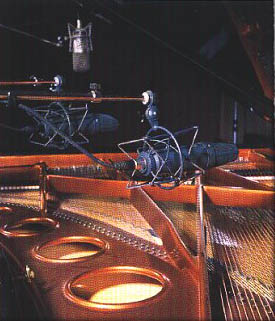 Mark Hawley: "The last album was quite a classical sounding thing and a very personal project for Tori. It did extremely well in the States and it will always be one of my favourites, but the record company were rather unsure about it. I guess it was not too great on radio because it was so dynamic, and so this time we decided to make a bit of a pop album. Tori had never recorded with a drummer before -- she had always recorded piano and vocals then we put any drums on top. That was a great way of working for her because a lot of what she does is improvised, and working with a drummer would have been too restricting, but we found Matt Chamberlain and she got on so well with him that a lot of the tracks on the new album are her singing and playing the piano with Matt drumming along live."
Mark Hawley: "The last album was quite a classical sounding thing and a very personal project for Tori. It did extremely well in the States and it will always be one of my favourites, but the record company were rather unsure about it. I guess it was not too great on radio because it was so dynamic, and so this time we decided to make a bit of a pop album. Tori had never recorded with a drummer before -- she had always recorded piano and vocals then we put any drums on top. That was a great way of working for her because a lot of what she does is improvised, and working with a drummer would have been too restricting, but we found Matt Chamberlain and she got on so well with him that a lot of the tracks on the new album are her singing and playing the piano with Matt drumming along live."
Did you build your new studio specifically to record this album?
Mark Hawley: "No. Tori needed a studio which she likes and where she can work whenever she wants. We have a few ideas of other bands and projects we want to do there -- when time permits, of course. I moved into the cottage in Cornwall exactly a year ago and since then we have completed the studio, recorded the album, mastered it in the control room with Jon Astley, and prepared for the new world tour which we start tomorrow!"
Marcel Van Limbeek: "This new album was done extremely quickly. We started it on 8th September and it took less than six months from start to finish -- we mastered it at the start of February."
Mark Hawley: "The building work was only just finished in time to start the recording -- it got very close. In fact the window went into the drum room after the drum kit had been set up! One of the key factors in designing the studio was that there had to be a good live room because Tori plays the piano whenever she performs and that needs a big, good sounding room. Also, because she wanted to play with a live drummer for this album, we knew we needed another separate room for the drums, so that was basically what determined the layout."
Marcel Van Limbeek: "We decided to have a very big control room too, so that when Tori was playing live with the drummer (in their separate rooms), we had Caton (guitar) and Bull (bass) playing in the control room behind the desk, together with the programmer and his racks of gear. That all worked really well because we had so much space in the control room."
Mark Hawley: "When you think about recording from the engineer's point of view you always think about acoustics and equipment -- which are really important of course -- but as you go on recording musicians you realise that most of them hate studios and the whole vibe of the thing. It is not a great atmosphere to get the best from them, so the whole Cornwall project was designed with that in mind. I think the key to working in studios is to not make the musicians feel like they are in an alien environment, but also to have the chance to experiment with the equipment. If you can get a good crossover between those two things, you should come out with a great result."
Is being so far away from London a bonus or a drawback?
Mark Hawley: "Personally, I find having the studio 'out of the way' in Cornwall a big advantage, because we don't have people coming over just to hang out for an hour -- anyone who comes is there for a reason. In most London studios, people are wandering in and out all the time and it can be very disruptive.
FITTING OUT THE STUDIO
Mark Hawley: "We used a Neve VR board for the last album, which we liked a lot, but we also used the new SSL for some B-sides. The SSL is a beautiful desk, an we went over Oxford to have another look at it, but at the end of the day we both loved the sound of the Neve so that is what we put in the new studio. The great thing about the Neve is how open it sounds and the Boys for Pele album was really all about the sound of that desk.
"The main monitoring is a pair of Genelec 1037s with a pair of excellent Mission hi-fi speakers for nearfields, which may seem unusual but there is a story behind them. When I'm touring I always have a pair of speakers on the desk, live. For the '94 tour I dashed into a hi-fi shop in Birmingham, listened to few pairs of speakers and walked out with these Missions which I used all through the tour, and they have proved so good that they have since grown into our domestic reference monitors. We tried other nearfields for this album but we kept coming back to the Missions. When Jon Astley brought his mastering set-up down with him for this album he used his PMC monitors, which are beautiful sounding speakers, but the Missions stood up really well in comparison. Unfortunately I don't think they make these particular Missions anymore."
Marcel Van Limbeek: "We often use the small Genelec 1031s as nearfields in other studios, but it would be silly to have them as nearfields here when we have the 1037s as the main monitors. We have a pair of NS10s which we never use, and although on the last album we didn't mix on the Missions, we did use them a lot for playbacks in other rooms to check what we had done."
Have you had to develop any specific mic techniques to record Tori?
Marcel Van Limbeek: "For the Pele album we used Neumann U87s on the piano, both in the studio and on stage during the tour, simply because they sound nice, and round, and big. On the new album we still used the U87s on some tracks, but we also used AKG C414s because they make the Bosendorfer sound much more like a 'pop' piano. It sounds slightly smaller, but it doesn't sound brittle, and it sits better in the mix with the drums and the rest of the band. We also tried using a U87 on the low end and a C414 on the high end to get a really great blend of warmth and brightness, which worked very well on some tracks."
Mark Hawley: "I think on the previous album the microphone choice was more critical because of the natural, real feel to it. On this album, though everything is so hard and compressed to give it a pop sound that microphone choice plays a smaller role."
Marcel Van Limbeek: "There are also far more elements in this album. Solo piano and voice are more exposed, so microphone choice is very important, but on this new album there is much more going on and maybe diaphragm valve mics wouldn't be so good -- you can't have everything sounding huge."
Mark Hawley: "We generally used a Neumann U87 or M49 valve for Tori's vocals, and although the normal approach might simply be 'OK, you are a singer -- so sing, and I'm going to record your voice", Tori makes you realise that sometimes she is singing from her stomach, and other times from her throat, and they are very different things. Once you understand that, and learn to work with it, you can get a lot more our of her vocals."
Marcel Van Limbeek: "We developed a set-up in the studio for Tori's vocals which involves a Focusrite Red 2 EQ, and a TubeTech LCA2-B valve compressor. We used that pretty much for everything on Boys for Pele, and although we experimented a bit more on the new album, like using the EQ on a Mackie desk just for the hell of it, we kept coming back to this set up."
I've heard stories about strange singing booths. Can you tell me more?
Mark Hawley: "Something that freaked us out when we first started recording Tori was separation between voice and piano, and we had seen pictures of her previous recording sessions with the piano covered with a heavy blanket to get better separation. On the previous album we found a beautiful church with a fantastic acoustic which we wanted for the piano and harpsichord, but the harpsichord is about a tenth of the volume of the piano, and we were very concerned about her vocals getting on the harpsichord mics. So, to try and keep some separation, we built this ridiculous wooden booth construction, which Tori sat in with the keyboards poking through a slot in the bottom -- it was every bit as bizarre as it sounds! We made the inside as dead as possible so it didn't sound too boxy, and it worked surprisingly well.
"I think you can go too far in trying to get everything completely separate, and there is a danger that you might lose the ambient sound of the room. A bit of crosstalk is perfectly OK, so with this album we used a simple sound board which went over the front of the piano to provide a degree of screening. We still had some crosstalk between the voice and piano, but at least it was reflected rather than direct sound."
Marcel Van Limbeek: " We don't really have any fixed ideas about mic techniques. If we don't know what is going to happen then we tend to stick with the old favourites like a Shure SM57, a U87 or a Neumann KM140, depending on what the source is. But other than that we don't really have favourites as such. If you have the time, I think it is always worth experimenting anyway. The U87 is the workhorse in the studio, much like the SM57 is for live sound, and although they are coloured compared to B&Ks, they are coloured in a very musical way which is why I like them so much.
Marcel Van Limbeek: "For the new album we mike every drum up separately but conventionally, although sometimes we would just use a pair of overheads, or maybe even just one distant room mic. We also changed the acoustics of the room, to make it more dead sometimes. It really all depended on the kind of sound we wanted for the music, and what the track was all about."
Mark Hawley: "That was the fun thing about this album compared to the last. On the last album it was all about pure audio, and if we put drums on a track, they had to sound like pure drums. This album was much more about how could we f**k the sound up to make it more pop orientated. For example, Matt (drummer) brought in this nasty little box which was some kind of really stupid limiter with an outrageously long release time. You can put up an mic anywhere in the room and you get this amazing sound!"
Does Tori get involved in the technical or production sides?
Mark Hawley: "Tori is a pure musician and isn't interested in the technical aspects, but the great thing about working with her is that she is never unsure about anything. She will make a decision and will say when something is right. A lot of artists are quick to say when something is wrong, but Tori will say when it is right too, and you know when she says that, it is right, and she won't change her mind again. A lot of musicians like Tori find it very hard to listen to a mix as you are building it up, and not automatically hear it as the finished thing, so although we might be quite happy with a quick reverb slapped on the vocal, and a rough drum reverb as we are building the mix, whenever Tori walks in she hears it as the finished thing."
Marcel Van Limbeek: "You know you couldn't say to her 'Listen to this, but we haven't done anything with the backing vocals yet' because she wouldn't say 'this is great', she'd say 'where are the backing vocals?'. Timing is everything in terms of when she listens to the mixes, so we would tell her when we had finished a track and then she could come and listen and anything she had to say was relevant."
How did you record and master the album
Mark Hawley: "The album was recorded onto a Sony DASH 24-track with a bunch of Tascams slaving off it. That was a great way of working because if you have something like a 48-track Sony you still only have one bit of tape, but with the Tascams locked up you can just keep recording more takes by putting new tapes in. Having said that, I think it is very important to come up with a performance and decide at the time what you want to keep, because the down side with this technique is that it can sometimes take forever to find the take you want from a large pile of cassettes! Rob Van Tuin, our studio tech, made an amazing database which we use to log everything during the session, and that makes it easier to find things. Tori also has an incredible memory for the detail of what we did on each session."
Mark Hawley: "When we came to mixing the album we used three formats. Boys for Pele was mastered to DAT using the Apogee AD1000, but now they have a new 24-bit system which they managed to get together for us. Unfortunately, because it was so new it wasn't totally reliable, and so we decided to play safe and master to both DAT and to a Tascam DA88 with a bit-splitting box to handle the full 24-bit audio. The A&R guy from the record company also suggested mastering the album onto half-inch analogue, so we did that too.
"The analogue sounded gorgeous, but we didn't actually use it at all for the CD. I think you really need to concentrate on what you are doing to get the best out of analogue, and because we were going down to three formats at the same time, it lost out something there. The 24-bit Tascam was fantastic oo - really clean and open - and we used that for a few tracks, but most were taken from the DAT because it was so 'in your face' and that is what the album is really about."
THE TOURING BAND
Mark Hawley: "Tori has a huge cult following in the USA -- it's difficult to explain to people in this country just what a presence she has over there. We were regularly doing sheds with 12,000 people, but over here the biggest thing we do is 2 nights in the Albert Hall. Tori hasn't played with a live band since she became successful, so this tour is something rather different. She has such a good reputation for performing live in America, and that has a lot to do with the fact that the songs change every night, and she alters the set drastically to suit the audience. Obviously that is much harder to do with a full band on stage, but I think as the tour progresses the band are such accomplished players that it could quickly turn into something really special.
"In terms of the equipment, we are virtually duplicating the effects we used in the studio because they really shaped the sound of the new album . We're even taking Lexicon 480Ls out with us, which is pretty unusual in live sound, and we're also using a lot of Focusrite EQs and preamps."
Is it a big problem keeping the foldback out of the piano?
Mark Hawley: "You don't come across nine-foot Bosendorfer pianos on live tours a lot, and we asked everyone for ideas on how to deal with it. We tried everything -- all the usual bugs and pick-ups -- but nothing worked as well as the classic studio technique of a pair of good cardioid mics. The whole idea of the bugs is to try to get rid of the ambient noise on the stage, but a lot of that is picked up directly by the piano itself -- the sound board resonates in sympathy. With the piano lid open it can pick up so much ambient sound that before the show has started the piano mic channel meters on the desk would often be peaking up to the top just with the audience noise! We found if the ambient noise is already in the piano, using a pair of mics like Neumann U87s gives you a much better sound quality than all the bugs."
Marcel Van Limbeek: "On the last tour we used more or less the same microphones on stage as we used in the studio, although you obviously can't do that with Tori's vocal microphone. We used a U87 or a Neumann M49 in the studio, but on stage we used a Neumann KM140 which is a great mic, and I guess we will do the same on this tour."
"In the first part of this new tour of America we're doing smallish clubs, so we're taking a baby Bosendorfer -- Tori's big one will come over when we do the big stadiums. Both pianos have been fitted with Bosendorfer's own MIDI system which drives a Kurzweil piano sampler, and I'll probably be using that in all the band numbers rather than the piano mics. In the past, if we had ever suggested having a MIDI piano or sampler Tori would have freaked -- her thing has always been about the sound of the Bose, but she has really changed her attitude for this tour because of the live band."
Will you be recording the tour, perhaps for a live album?
Mark Hawley: "We recorded both the previous tours but with just solo piano and vocals the recordings really didn't work as a piece of audio because of all the crosstalk. We had some B-sides off the last two tours, but they were really the best recorded tracks from 200 shows. This tour is totally different because of the band element, so we're going to record all the shows and an album might come out of that -- it is more controlled this time especially with the MIDI piano and everything."
Marcel Van Limbeek: "All the mics and DIs from the stage would normally go to both the monitor and FOH desks, but we are routing them to a rack of Focusrite preamps - an unusual approach in itself - and then to a rack of active BSS splitters with feeds to the monitor desk, FOH desk, and a pile of Tascam DA88s. There are 40 lines off the stage, and we have six Tascams so there is a spare in the system just in case. It is an unusual way of working, but the beauty of the system is that by swapping just one multi around, we can replay from the DA88s back into both desks, and sound check with last night's show without having to have Tori around. It also means we can work out new effects or something just like in the studio by working around the DA88 tapes."
"Tori is not big on rehearsing in sound checks, and she actually does a lot of her writing then, so I usually have to keep a DAT running for her and can't easily try new things out. The other thing she does a lot is use the sound check for the local press reports, so I often have to give the local TV people a sound feed rather than doing a proper sound check. So the Tascam idea is extremely useful from several points of view."
Do you enjoy combining the studio and live sound roles?
Mark Hawley: "Although it's really great doing both the studio album and the live tour, it has been completely manic! Normally, there are entirely different teams of people looking after the two sides of it, but with this, it's all the same people. Even John, the tour manager, has been the production manager for the album, so it has been pretty hectic finishing off the album and getting ready for the tour. Of course, it's a great opportunity and very rare to follow through from the studio recording to the live tour, so even though it's all total chaos, it is still fantastic!"
t o r i p h o r i a
tori amos digital archive
yessaid.com
|